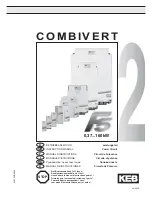
4---8
insulation used. The latest and newest in insulation and
baking techniques are used.
The finest insulation job can be very quickly broken
down by carelessly applying high voltage to windings in a
moisture saturated condition. Mishandling in this respect
can easily cause a breakdown, making it necessary to
return the generator to the factory for repair, and
consequent expense and loss of time.
WARNING
High voltage (dielectric) testing must not be
performed to the machine without first
observing NEMA rules. The insulation of this
generator winding may be safely checked by
using a megger. A high megger reading indicates
low insulation leakage.
g. Restoring Residual Magnetism
NOTE
When trying to restore residual magnetism, be
sure to wear leather gloves and use an insulated
12 gauge (or higher) jumper wire. Cut---off a few
strands from both ends of the jumper wire to
help ensure fusing does not take place.
The direct current (DC) necessary to magnetize the
alternator field is obtained from the exciter. Initially,
upon starting the generator, current flow and voltage are
induced into the exciter armature by the magnetic lines of
force set up by the residual magnetism of the exciter field
poles.
Residual magnetism of the exciter field poles may be
lost or weakened by a strong neutralizing magnetic field
from any source, or if the generator is not operated for a
long period of time.
Should the generator fail to build up voltage after
being disassembled for any reason, a momentary short---
circuit of any two generator leads (L1, L2 and L3) while
generator is running should be sufficient to correct this
condition. If not, an alternate method may be used.
Apply either an alternating current or a direct current
voltage of approximately 20 volts to any two generator
leads (L1, L2 and L3) while generator is running. Do not
make a positive connection but rather touch the leads
together until the generator voltage begins to rise and
then remove. It is suggested that a 30 ampere fuse be
inserted in the circuit to prevent any damage in case the
build---up voltage is not removed quickly enough.
Reflash field if generator output voltage does not
build up.
4.6.2Installation and Removal
a. Removing the Generator
1. Remove ground wire from frame of generator set.
2. Remove generator leads from power junction box,
then remove four 1/4---20 x 1/2 thread cutting screws
securing box to generator.
3. Remove screen from coupling end of generator.
4. Remove five 3/8---24 x 3/4 hex head screws and
washers securing generator disc to engine flywheel. (A
socket brazed to a flexible shaft and an offset wrench are
required to remove the bolts.) Turn bolts counter---clock-
wise with offset wrench to start, then use flexible shaft
and socket assembly for removal of bolts.
5. Remove six 5/16---18 x 1---1/4 bolts and washers
that secure generator to engine housing. Two bolts are
5/16---18 x 1---1/2 lg. (Secure bracket)
6. Remove mounting foot hardware, then remove
generator.
b. Installing the Generator
The generator is a single bearing type which means
the shaft end of the rotor floats. Before installing
generator, rotate shaft and check if bearing rotates.
The use of stud guides, two in bell housing (5/16---18 x
2 lg) and two in the flywheel (3/8---24 x 2---1/2 lg) will make
installation easier. These studs should have a square or
hex design on the end opposite the threads. This is
necessary to remove studs after generator is installed.
1. Remove screen covering from shaft end of genera-
tor and brush anti---seize lubricant (lube---plate) on the
face of flywheel.
2. Move generator (with hoist) into position and line
up with the studs on housing and flywheel. Turn
crankshaft (with large wrench) to align flywheel with
generator, if necessary.
NOTE
It may be necessary to apply pressure under the
cooling fan to align the generator with the
flywheel counterbore.
3. Start the 3/8---24 bolts (by hand) through the disc
plate and into the flywheel.
4. Secure two of the housing bolts (5/16---18) to draw
the mating flanges together.
5. Remove studs and secure remaining bolts and
washers. The 5/16---18 bolts (six) are to be torqued to a
value of 15
¦
2 ft---lb (2
¦
0.3 mkg). The 3/8---24 bolts
(five) are to be torqued 25
¦
2 ft---lb (3
¦
0.3 mkg).
NOTE
Install new gaskets (one between generator and
junction box and the other between box and
cover) when installing junction box.
6. Install screen cover, mounting bolts, power junc-
tion box and wiring. Torque generator mounting bolts
(5/8---11) to a value of 70 ft---lb (9.68 mkg).








































